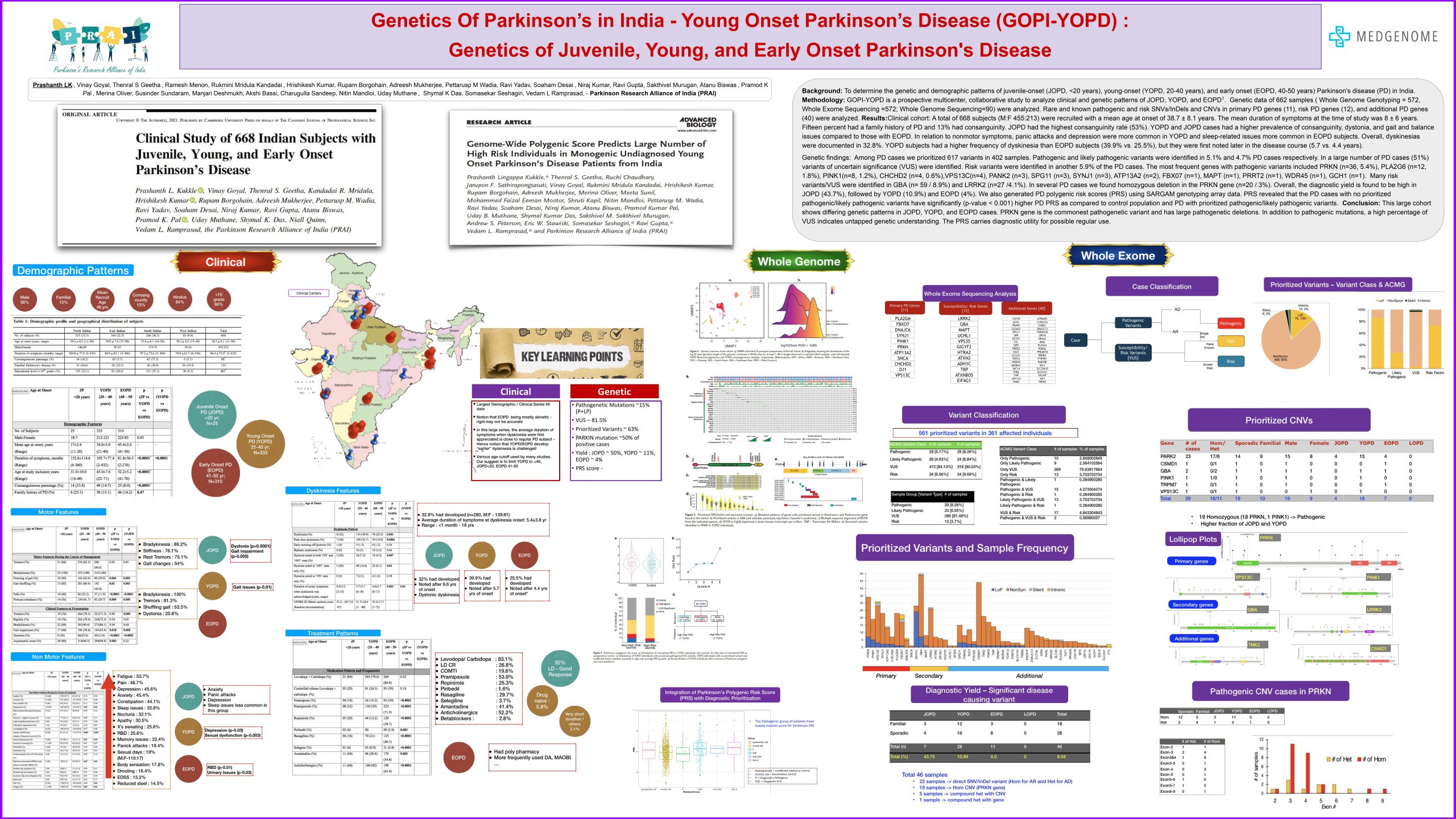Genetics Of Parkinson’s in India – Young Onset Parkinson’s Disease (GOPI-YOPD) : Genetics of Juvenile, Young, and Early Onset Parkinson’s Disease

Prashanth LK, Vinay Goyal, Thenral S Geetha, Ramesh Menon, Rukmini Mridula Kandadai, Hrishikesh Kumar, Rupam Borgohain, Adreesh Mukherjee, Pettarusp M Wadia, Ravi Yadav, Soaham Desai, Niraj Kumar, Ravi Gupta, Sakthivel Murugan, Atanu Biswas, Pramod K Pal, Merina Oliver, Susinder Sundaram, Manjari Deshmukh, Akshi Bassi, Charugulla Sandeep, Nitin Mandloi, Uday Muthane, Shymal K Das, Somasekar Seshagiri, Vedam L Ramprasad, – Parkinson Research Alliance of India (PRAI)
Presented as abstract at the International Parkinsons and Movement Disorders Society Conference held in September 2022 at Madrid, Spain.
Background:
To determine the genetic and demographic patterns of juvenile-onset (JOPD, <20 years), young-onset (YOPD, 20-40 years), and early onset (EOPD, 40-50 years) Parkinson’s disease (PD) in India.
Methodology:
GOPI-YOPD is a prospective multicenter, collaborative study to analyze clinical and genetic patterns of JOPD, YOPD, and EOPD1. Genetic data of 662 samples ( Whole Genome Genotyping = 572, Whole Exome Sequencing =572; Whole Genome Sequencing=90) were analyzed. Rare and known pathogenic and risk SNVs/InDels and CNVs in primary PD genes (11), risk PD genes (12), and additional PD genes (40) were analyzed.
Results:
Clinical cohort: A total of 668 subjects (M:F 455:213) were recruited with a mean age at onset of 38.7 ± 8.1 years. The mean duration of symptoms at the time of study was 8 ± 6 years. Fifteen percent had a family history of PD and 13% had consanguinity. JOPD had the highest consanguinity rate (53%). YOPD and JOPD cases had a higher prevalence of consanguinity, dystonia, and gait and balance issues compared to those with EOPD. In relation to nonmotor symptoms, panic attacks and depression were more common in YOPD and sleep-related issues more common in EOPD subjects. Overall, dyskinesias were documented in 32.8%. YOPD subjects had a higher frequency of dyskinesia than EOPD subjects (39.9% vs. 25.5%), but they were first noted later in the disease course (5.7 vs. 4.4 years).
Genetic findings: Among PD cases we prioritized 617 variants in 402 samples. Pathogenic and likely pathogenic variants were identified in 5.1% and 4.7% PD cases respectively. In a large number of PD cases (51%) variants of uncertain significance (VUS) were identified. Risk variants were identified in another 5.9% of the PD cases. The most frequent genes with pathogenic variants included PRKN (n=36, 5.4%), PLA2G6 (n=12, 1.8%), PINK1(n=8, 1.2%), CHCHD2 (n=4, 0.6%),VPS13C(n=4), PANK2 (n=3), SPG11 (n=3), SYNJ1 (n=3), ATP13A2 (n=2), FBX07 (n=1), MAPT (n=1), PRRT2 (n=1), WDR45 (n=1), GCH1 (n=1). Many risk variants/VUS were identified in GBA (n= 59 / 8.9%) and LRRK2 (n=27 /4.1%). In several PD cases we found homozygous deletion in the PRKN gene (n=20 / 3%). Overall, the diagnostic yield is found to be high in JOPD (43.7%), followed by YOPD (10.9%) and EOPD (4%). We also generated PD polygenic risk scores (PRS) using SARGAM genotyping array data. PRS revealed that the PD cases with no prioritized pathogenic/likely pathogenic variants have significantly (p-value < 0.001) higher PD PRS as compared to control population and PD with prioritized pathogenic/likely pathogenic variants.
Conclusion:
This large cohort shows differing genetic patterns in JOPD, YOPD, and EOPD cases. PRKN gene is the commonest pathogenetic variant and has large pathogenetic deletions. In addition to pathogenic mutations, a high percentage of VUS indicates untapped genetic understanding. The PRS carries diagnostic utility for possible regular use.
Reference:
- Kukkle PL, Goyal V, Geetha TS, Mridula KR, Kumar H, Borgohain R, Mukherjee A, Wadia PM, Yadav R, Desai S, Kumar N, Gupta R, Biswas A, Pal PK, Muthane U, Das SK, Quinn N, Ramprasad VL; Parkinson Research Alliance of India (PRAI). Clinical Study of 668 Indian Subjects with Juvenile, Young, and Early Onset Parkinson’s Disease. Can J Neurol Sci. 2022 Jan;49(1):93-101. doi: 10.1017/cjn.2021.40.


Harrison Eskola
Can I just say what a relief to get an individual who really knows what theyre talking about on the net. You unquestionably know how you can bring an problem to light and make it important. A lot more individuals need to read this and realize this side of the story. I cant believe youre not additional common simply because you definitely have the gift.
Unlocking India's Genetic Code: Revelations and Challenges in Parkinson's Disease Research | Parkinsons Disease and Movement Disorders Clinic
[…] disease (YOPD) in Indian population. The Genetics of PAN-India Young Onset Parkinson Disease (GOPI-YOPD), a multicentre Pan India project- recruited 1000 patients through a network of 10 specialty […]
Genetic Links to ‘Young-Onset Parkinson’s Disease’ Among Indians - Goripalya.com
[…] Go to source […]
Genetic Links to ‘Young-Onset Parkinson’s Disease’ Among Indians - 2 Minutes Info
[…] Go to source […]
Genetic Affiliation Of 'young-onset Parkinson's Illness' In Indians
[…] pass to supply […]
Genetic Associations with Early-Onset Parkinson’s Disease in the Indian Population – NEUS CORP
[…] Go to source […]
भारतीयों में 'युवा-शुरुआत पार्किंसंस बीमारी' की आनुवंशिक संबद्धता FlashNews18-HINDI
[…] आपूर्ति के लिए पास करें […]
Genetic Links To ‘Young-Onset Parkinson's Disease’ Among Indians - MEEFRO
[…] Go to source […]
Genetic Links to ‘Young-Onset Parkinson’s Disease’ Among Indians – DN – We the women
[…] Go to source […]